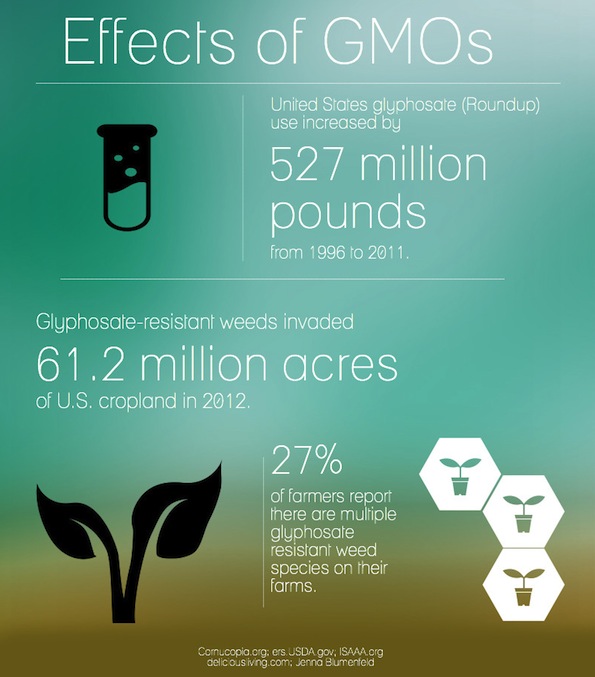What You (and Your Customers) Should Know About GMOs
In recent years, people worldwide have grown increasingly attuned to genetically modified organisms, or GMOs. Nearly 2 million people participated in a global non-GMO “March against Monsanto” last May. More than 20 states now have GMO labeling legislation in the works. And in a game-changing move, in March 2013, Whole Foods Market announced that by 2018 all items sold in its stores must include GMO labeling. “We are putting a stake in the ground on GMO labeling to support the consumer’s right to know,” said co-CEO Walter Robb.
But for many of us, GMOs are still a mystery. What are they? How do they impact our health and environment? And what’s being done to label them? Here’s a quick overview of GMOs from seed to plate.
Made in a lab
There’s little argument over what genetic modification is: Scientists remove a gene from one organism and transfer that gene to a different organism. Unlike traditional methods, where farmers might breed plants from the same species to make a stronger plant, GM technology makes it possible to transfer any gene from any organism into a different one.
For example, Bt corn, developed in 1996, contains a gene from soil bacteria that’s toxic to insects. Scientists first isolate the desired bacterium DNA. “They then use a ‘gene gun’ to shoot [the bacteria] genes into a Petri dish full of corn embryos,” explains Gregory Jaffe, director of biotechnology projects at the Center for Science in the Public Interest. “They hope a bit of DNA randomly gets through the corn cell membrane. If it does, scientists take that embryo and grow a plant from it.” The resulting plant expresses the gene—in Bt’s case, an insecticide—in every one of its cells, enabling the corn itself to kill bugs. Needless to say, this scenario would never occur in nature—but as of 2012, Bt corn makes up 67 percent of all American corn acreage.
Spread in a field
Even more widespread than Bt corn are herbicide-tolerant crops that survive glyphosate, the weed killer known as Roundup. (Fittingly, these crops are called Roundup Ready.) Companies that manufacture Roundup Ready corn, cotton, and soybeans claim these crops are the solution to the world’s food problems, insisting that the GMO versions have higher yields, benefit farmers and the environment, and reduce herbicide use.
Anti-GMO activists disagree. “When [Roundup Ready] technology first came onto the market in 1996, most farmers had excellent weed control with only one herbicide application per crop,” says Chuck Benbrook, a research professor at Washington State University who studies genetically engineered crops. “But by 2000, the first Roundup tolerant weeds started to emerge in fields and were surviving a low application rate.” Fighting these progressively more resilient weeds is a snowballing struggle because farmers must incrementally up herbicide use. Since GMOs were adopted, farmers have increased herbicide use by 7 percent.
This worries Benbrook. “The sheer volume of glyphosate has led to soil changes that reduce a plant’s ability to draw up various mineral micronutrients [like zinc, chromium, and manganese],” he says. This also renders plants vulnerable to bacterial and fungal attacks. The downside? Lower crop yields, less nutrition, and more fungicide spraying.
Plus, a whole host of negative effects result from massive Roundup use. Most recently, a study published in the scientific journal Entropy suggests that long-term exposure to glyphosate residues could be linked to a suite of human health issues, including gastrointestinal disorders, Alzheimer’s, and certain cancers. As weeds continue to become even more resistant, heavier glyphosate use and more precarious herbicides (such as 2,4-D, an ingredient in Agent Orange) lurk on the horizon. Frighteningly, these higher-risk chemicals have a nasty habit of drifting.
Just label them
The Grocery Manufacturers Association estimates that a whopping 75 percent to 80 percent of conventional processed foods now contain GMOs. Even foods that don’t list corn, soy, or canola as a main ingredient can still be GMO-laden because of sneaky additives like ascorbic acid, maltodextrin, sugar from beets or corn, lactic acid, and more.“Products with seemingly low risk ingredients often have ones that could contain GMOs,” says Courtney Pineau, assistant director for the Non-GMO Project, a certification organization. “It’s surprising where GMOs can pop up, and it’s changing all the time.” Translation: If you’re not buying USDA Organic (which, by definition, excludes GMO ingredients), you’re probably eating GMOs.
Non-GMO proponents insist that labeling foods containing GMOs is paramount. While nearly 60 countries, including Australia, Japan, and the EU mandate GMO labeling, the United States does not, so you have no way to know what you’re eating or feeding to your family.
That doesn’t sit well with a lot of people. Since Whole Foods announced its labeling initiative, the Non-GMO Project has fielded a surge of inquiries from natural manufacturers wishing to attain the Non-GMO Project Verified seal. “A lot of this interest has to do with the impacts of the Right to Know movement, efforts from the Just Label It campaign, state initiatives, and increased outreach and education from Non-GMO Project Verified companies,” says Pineau.
The FDA maintains its position that GMOs are harmless, claiming there’s no evidence to substantiate adverse health effects. But the opposite is also true: There’s inconclusive evidence to show that they’re safe. According to a growing base of scientists, food experts, and citizens, you have the right to know what’s in your food and to choose or avoid products based on that knowledge.
